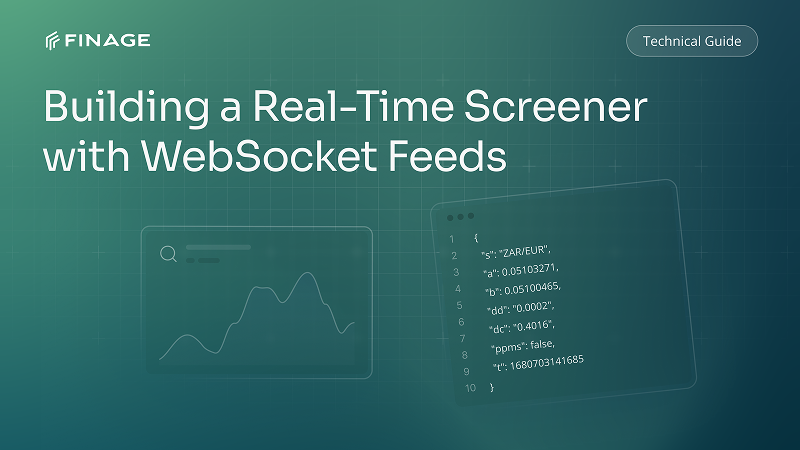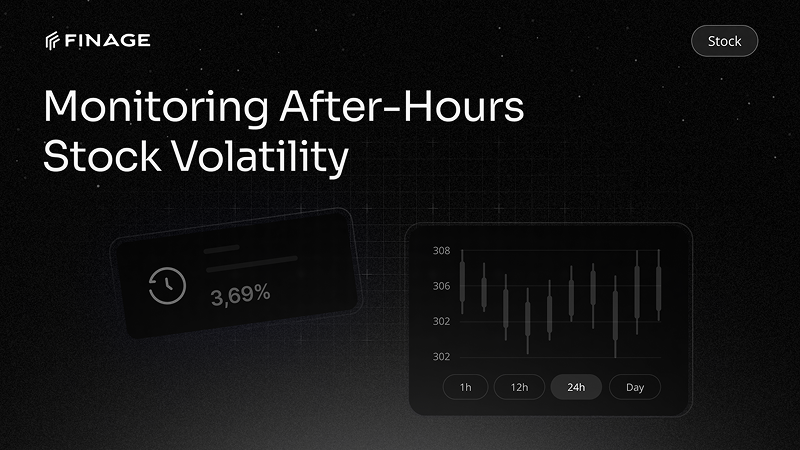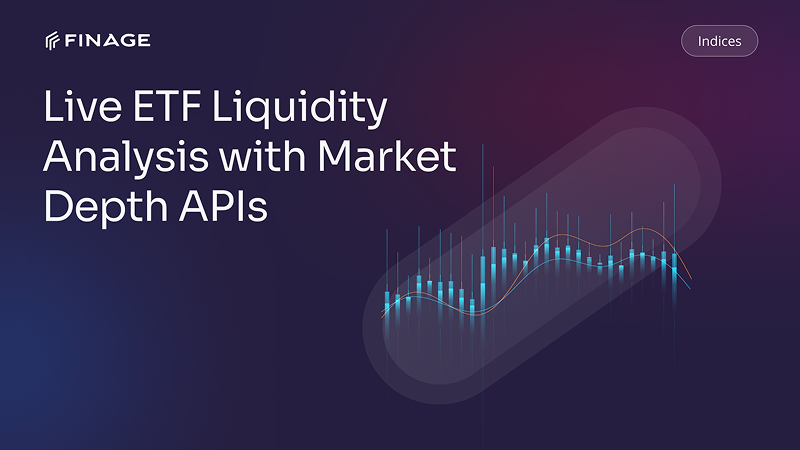Forex Market Depth: How Finage API Helps You Go Beyond Just Rates
7 min read • July 10, 2025

Introduction
Most Forex platforms stop at top-level pricing—just the bid and ask. But serious traders, fintech builders, and institutional tools need more. They need depth.
Market depth shows what lies beneath the surface: how much volume is available at different price levels, how liquidity shifts during volatility, and where large players are positioning themselves. It’s the foundation of informed trading, risk management, and execution quality.
With the Finage Forex API, you’re no longer limited to spot rates. You gain access to layered data that reveals the true structure of the market—helping you build smarter dashboards, stronger algos, and more transparent products.
In this article, we’ll explore how market depth transforms Forex trading—and how Finage makes that transformation accessible through scalable, developer-ready APIs.
Rates tell you the price. Depth tells you the story.
Table of Contents
- What Is Market Depth in Forex and Why It Matters
- The Limitations of Spot Rates Alone
- How Finage API Exposes Forex Depth Across Pairs
- Use Cases: From Algos to Analytics Dashboards
- Best Practices for Integrating Depth Data
- Final Thoughts — Trade With Insight, Not Just Price
1. What Is Market Depth in Forex and Why It Matters
Market depth, often referred to as Level 2 data, goes beyond the best bid and ask. It reveals the range of pending buy and sell orders at various price points. This layered insight helps traders and developers assess how liquidity is distributed across the order book.
In the Forex market, depth typically shows:
- Multiple tiers of bid and ask prices (not just the top-level spread)
- Volume at each tier – how much can be bought or sold at each level
- Order book dynamics – how liquidity shifts over time or during events
Why does this matter?
Because surface-level rates don’t reflect the real tradability of an asset. A tight spread may look good, but if there’s only 10K of liquidity and you need to move 1M USD, you’ll experience slippage—potentially significant.
Market depth enables:
- Execution planning: Avoiding slippage by breaking orders across tiers
- Liquidity analysis: Identifying strong vs. weak currency pairs
- Pre-trade risk checks: Evaluating whether a pair is too thin for your strategy
- Transparency in pricing: Understanding why rates spike during macro events
In volatile conditions, it's not the rate that fails you—it’s the lack of depth behind it.
2. The Limitations of Spot Rates Alone
Most Forex APIs, dashboards, and even many trading terminals only show the top-of-book—the current best bid and ask. While this is useful for a quick glance, it hides the underlying structure of the market.
Spot rates are:
- Ephemeral: They update rapidly but don’t reveal what’s happening underneath
- Volume-agnostic: You can’t tell if the quote is for $100 or $10 million
- Blind to market intent: They don't show how deep or shallow the liquidity really is
What gets missed when you only see the top-level?
- Hidden Illiquidity: A narrow spread can be misleading if depth dries up after the first tier
- Sudden Volatility: Without depth, large trades can distort prices dramatically and unexpectedly
- Execution Inefficiency: Traders can’t assess where to break larger trades or how slippage might affect them
Let’s say your trading app monitors EURUSD and sees a 0.1 pip spread. Without depth data, it can’t know that the next best price is significantly worse—or that the liquidity is just a fraction of what it appears to be.
That’s where Finage stands out. Its Forex API gives access to structured market depth data across currency pairs, not just the headline price.
Spot rates give you the price. Depth shows whether that price can be trusted.
3. How Finage API Exposes Forex Depth Across Pairs
While many data providers stop at top-level quotes, Finage delivers full market depth for Forex pairs—enabling developers and fintech builders to build more intelligent, transparent, and responsive tools.
Through the Finage Forex API, you can access:
- Multiple bid and ask levels: Not just the best prices, but a full ladder of quotes
- Real-time updates via WebSocket: Stream tick-level data with minimal latency
- Volume visibility per tier: See how much liquidity is available at each level
- Consistent symbol formatting: Standardized across all major and minor currency pairs
For example, a subscription to EURUSD might return several levels like:
- Bid: 1.1055 (100K), 1.1054 (150K), 1.1053 (50K)
- Ask: 1.1056 (120K), 1.1057 (100K), 1.1058 (30K)
This level of granularity helps you detect when liquidity is shifting—before the top-of-book changes. It also allows for smart order routing, where trades are split to avoid slippage or adjusted based on available depth.
And because Finage offers both REST and WebSocket access, you can choose the delivery method that best fits your app—batch analysis or real-time responsiveness.
When it comes to Forex, knowing the price is one thing. Knowing what’s behind the price is what gives you an edge.
4. Use Cases — From Algos to Analytics Dashboards
Forex depth data isn’t just for institutional trading desks. With Finage, developers, startups, and trading platforms can access the same layered insights and apply them in flexible, performance-driven ways.
Key applications include:
- Execution Algorithms
Depth data lets smart order routers and trading bots break large trades into smaller chunks, targeting multiple tiers to reduce slippage.
- Volatility and Liquidity Heatmaps
By tracking changes in depth across pairs, platforms can visualize thin vs. liquid markets, highlight imbalances, or detect stress during news events.
- Risk Management Dashboards
Portfolio tools and broker apps can use depth to evaluate currency exposure, flag thin liquidity pairs, or provide traders with execution warnings.
- Market-Making Bots
Depth information helps bots adjust spreads and size in real time—especially useful in synthetic pairs or when replicating CEX behavior.
- Institutional Client Transparency
Forex brokers and B2B apps can use depth to justify execution pricing, offer audit trails, or demonstrate price fairness to clients.
Finage gives you the tools to build all of this with normalized, real-time access and scalable performance—so your infrastructure doesn’t have to compromise.
Market depth is no longer a premium add-on—it’s a baseline for serious trading.
5. Best Practices for Integrating Depth Data
While accessing market depth through the Finage API is straightforward, building around it efficiently takes a few smart decisions. Here’s how to get the most from your integration—whether you’re building a bot, a dashboard, or a client-facing tool.
Choose WebSocket for Real-Time Applications
If your use case involves price alerts, algorithmic trading, or liquidity monitoring, the WebSocket API provides continuous streaming with sub-second latency—far better than polling REST endpoints.
Normalize Data Early in Your Pipeline
Even though Finage uses consistent symbol formatting, your application logic (especially when working with multi-asset environments) should treat depth feeds as structured JSON objects and map prices + volumes clearly per tier.
Monitor Spread Compression and Volume Decay
For trading strategies, consider not just price changes but how many levels show shrinking volume. When the book thins out, the risk of slippage increases—even if the top rate appears stable.
Store Depth Snapshots for Analytics
If you’re building a backtest or analytics feature, save periodic depth snapshots or deltas. This helps you evaluate how liquidity evolved during key events and improves your product’s transparency.
Set Alert Thresholds by Pair
Different currency pairs have vastly different liquidity profiles. Use pair-specific settings to determine when a depth shift matters—e.g., 1-pip move in EURUSD vs 3 pips in a minor pair like NZDCHF.
Finage handles the hard part—data collection, normalization, and delivery—so you can focus on applying insights, not chasing them.
A fast API is useful. A depth-aware trading system is powerful.
6. Final Thoughts — Trade With Insight, Not Just Price
Forex trading today isn’t about who sees the rate first. It’s about who understands what’s behind the rate. Market depth shows you the real structure of liquidity, the stability of a quote, and the pressure building at different levels—all critical to trading intelligently.
With the Finage Forex API and WebSocket stream, you gain access to real-time depth data across major, minor, and exotic currency pairs. Whether you’re optimizing trade execution, building visual analytics, or powering client-facing platforms, Finage helps you go beyond surface-level pricing.
Unlike many providers, Finage offers:
- A consistent schema across all pairs
- Tiered bid/ask data in real time
- REST and WebSocket options
- Infrastructure ready for scale and speed
Your platform doesn’t need more rates. It needs better market context.
Explore the Finage documentation to start building with Forex market depth—and give your users a smarter, more transparent experience.
Claim Your Free API Key Today
Access stock, forex and crypto market data with a free API key—no credit card required.

Stay Informed, Stay Ahead
Finage Blog: Data-Driven Insights & Ideas
Discover company news, announcements, updates, guides and more


